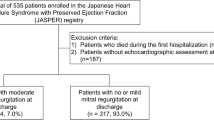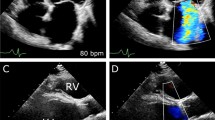Abstract
Background
Functional mitral regurgitation (MR) can be seen in patients with atrial fibrillation (AF), even without left-ventricular (LV) systolic dysfunction, as a result of left atrial enlargement. The purpose of this study was to evaluate the prognostic significance of residual functional MR in hospitalized heart failure patients with chronic AF and preserved LV ejection fraction (pEF) after medical therapies.
Methods
In this retrospective multi-center study, the determinants of post-discharge prognosis (cardiac death and re-hospitalization for worsening heart failure) were examined in 54 hospitalized heart failure patients with chronic AF and pEF at discharge.
Results
Of the 54 patients, 53 (98%) had mild or higher degrees of functional MR at hospitalization.At discharge, 47 (87%) still had functional MR, even after medical therapies [mild in 27 (50%), moderate in 16 (30%), and severe in 4 (7%)]. During the follow-up period (20 ± 16 months) after discharge, 16 (30%) patients met the composite end points. The grading of residual functional MR at discharge was the significant predictor of the end point (hazard ratio per one grade increase: 2.4, 95% confidence interval 1.1–5.5, p = 0.035). The greater the residual functional MR was, the lower the event-free rate from the end point was in the Kaplan–Meier curve analysis (p = 0.0069 for trend).
Conclusions
A substantial proportion of patients hospitalized due to heart failure with chronic AF have residual functional MR at discharge, even with pEF after medical therapies, and the MR is related to future heart failure events.




Similar content being viewed by others
References
Blondheim DS, Jacobs LE, Kotler MN, et al. Dilated cardiomyopathy with mitral regurgitation: decreased survival despite a low frequency of left ventricular thrombus. Am Heart J. 1991;122:763–71.
Agricola E, Ielasi A, Oppizzi M, et al. Long-term prognosis of medically treated patients with functional mitral regurgitation and left ventricular dysfunction. Eur J Heart Fail. 2009;11:581–7.
Kihara T, Gillinov AM, Takasaki K, et al. Mitral regurgitation associated with mitral annular dilation in patients with lone atrial fibrillation: an echocardiographic study. Echocardiography. 2009;26:885–9.
Gertz ZM, Raina A, Saghy L, et al. Evidence of atrial functional mitral regurgitation due to atrial fibrillation. J Am Coll Cardiol. 2011;58:1474–81.
Kilic A, Schwartzman DS, Subramaniam K, et al. Severe functional mitral regurgitation arising from isolated annular dilation. Ann Thorac Surg. 2010;90:1343–5.
Kajimoto K, Minami Y, Otsubo S, et al. Ischemic or non-ischemic functional mitral regurgitation and outcomes in patients with acute decompensated heart failure with preserved or reduced ejection fraction. Am J Cardiol. 2017;120:809–16.
Vahanian A, Alfieri O, Andreotti F, et al. Joint Task Force on the Management of Valvular Heart Disease of the European Society of Cardiology (ESC) and the European Association for Cardio-Thoracic Surgery (EACTS) Guidelines on the management of valvular heart disease (version 2012). Eur Heart J. 2012;33:2451–96.
Nishimura RA, Otto CM, Bonow RO, American College of Cardiology, American Heart Association Task Force on Practice Guidelines, et al. AHA/ACC guideline for the management of patients with valvular heart disease: a report of the American College of Cardiology/American Heart Association Task Force on Practice Guidelines. J Am Coll Cardiol. 2014;2014(63):e57–185.
Lang RM, Bierig M, Devereux RB, et al. Chamber Quantification Writing Group; American Society of Echocardiography’s Guidelines and Standards Committee; European Association of Echocardiography. Recommendations for chamber quantification: a report from the American Society of Echocardiography’s Guidelines and Standards Committee and the Chamber Quantification Writing Group, developed in conjunction with the European Association of Echocardiography, a branch of the European Society of Cardiology. J Am Soc Echocardiogr. 2005;18:1440–63.
Gudmundsson P, Rydberg E, Winter R, et al. Visually estimated left ventricular ejection fraction by echocardiography is closely correlated with formal quantitative methods. Int J Cardiol. 2005;101:209–12.
Zoghbi WA, Enriquez-Sarano M, Foster E, et al. American Society of Echocardiography. Recommendations for evaluation of the severity of native valvular regurgitation with two-dimensional and Doppler echocardiography. J Am Soc Echocardiogr. 2003;16:777–802.
Ommen SR, Nishimura RA, Appleton CP, et al. Clinical utility of Doppler echocardiography and tissue Doppler imaging in the estimation of left ventricular filling pressures: a comparative simultaneous Doppler-catheterization study. Circulation. 2000;102:1788–94.
Sumida T, Tanabe K, Yagi T, et al. Single-beat determination of Doppler-derived aortic flow measurement in patients with atrial fibrillation. J Am Soc Echocardiogr. 2003;16:712–5.
Ho JE, Gona P, Pencina MJ, et al. Discriminating clinical features of heart failure with preserved vs. reduced ejection fraction in the community. Eur Heart J. 2012;33:1734–41.
Zakeri R, Chamberlain AM, Roger VL, et al. Temporal relationship and prognostic significance of atrial fibrillation in heart failure patients with preserved ejection fraction: a community-based study. Circulation. 2013;128:1085–93.
Wang TJ, Larson MG, Levy D, et al. Temporal relations of atrial fibrillation and congestive heart failure and their joint influence on mortality: the framingham heart study. Circulation. 2003;107:2920–5.
Abe Y, Akamatsu K, Ito K, et al. Prevalence and prognostic significance of functional Mitral and tricuspid regurgitations occurring despite preserved left ventricular ejection fraction in patients with atrial fibrillation. Circ J. 2018;82:1451–8.
Abe Y, Akamatsu K, Furukawa A, et al. Pre-load-induced changes in forward LV stroke and functional mitral regurgitation: echocardiographic detection of the descending limb of Starling’s curve. JACC Cardiovasc Imaging. 2017;10:611–8.
Palardy M, Stevenson LW, Tasissa G, et al. ESCAPE Investigators. Reduction in mitral regurgitation during therapy guided by measured filling pressures in the ESCAPE trial. Circ Heart Fail. 2009;2:181–8.
Takahashi Y, Abe Y, Sasaki Y, et al. Mitral valve repair for atrial functional mitral regurgitation in patients with chronic atrial fibrillation. Interact Cardiovasc Thorac Surg. 2015;21:163–8.
Otsuji Y, Kumanohoso T, Yoshifuku S, et al. Isolated annular dilation does not usually cause important functional mitral regurgitation: comparison between patients with lone atrial fibrillation and those with idiopathic or ischemic cardiomyopathy. J Am Coll Cardiol. 2002;39:1651–6.
Ito K, Abe Y, Takahashi Y, et al. Mechanism of atrial functional mitral regurgitation in patients with atrial fibrillation: a study using three-dimensional transesophageal echocardiography. J Cardiol. 2017;70:584–90.
Nagueh SF, Smiseth OA, Appleton CP, et al. Recommendations for the evaluation of left ventricular diastolic function by echocardiography: an update from the American Society of Echocardiography and the European Association of Cardiovascular Imaging. J Am Soc Echocardiogr. 2016;29:277–314.
Author information
Authors and Affiliations
Corresponding author
Ethics declarations
Conflict of interest
Kazato Ito, Yukio Abe, Hiroyuki Watanabe, Yoshihisa Shimada, Kentaro Shibayama, Hiroki Oe, Eiichi Hyodo, Chinami Miyazaki, Yosuke Takahashi, Toshihiko Shibata, and Hiroshi Ito declare that they have no conflict of interest.
Human rights statements
Human rights statements and informed consent: All procedures followed were in accordance with the ethical standards of the responsible committee on human experimentation (institutional and national) and with the Helsinki Declaration of 1964 and later revisions.
Informed consent
Informed consent was obtained from all patients for being included in the study.
Additional information
Publisher's Note
Springer Nature remains neutral with regard to jurisdictional claims in published maps and institutional affiliations.
Rights and permissions
About this article
Cite this article
Ito, K., Abe, Y., Watanabe, H. et al. Prognostic significance of residual functional mitral regurgitation in hospitalized heart failure patients with chronic atrial fibrillation and preserved ejection fraction after medical therapies. J Echocardiogr 17, 197–205 (2019). https://doi.org/10.1007/s12574-018-0412-6
Received:
Revised:
Accepted:
Published:
Issue Date:
DOI: https://doi.org/10.1007/s12574-018-0412-6




